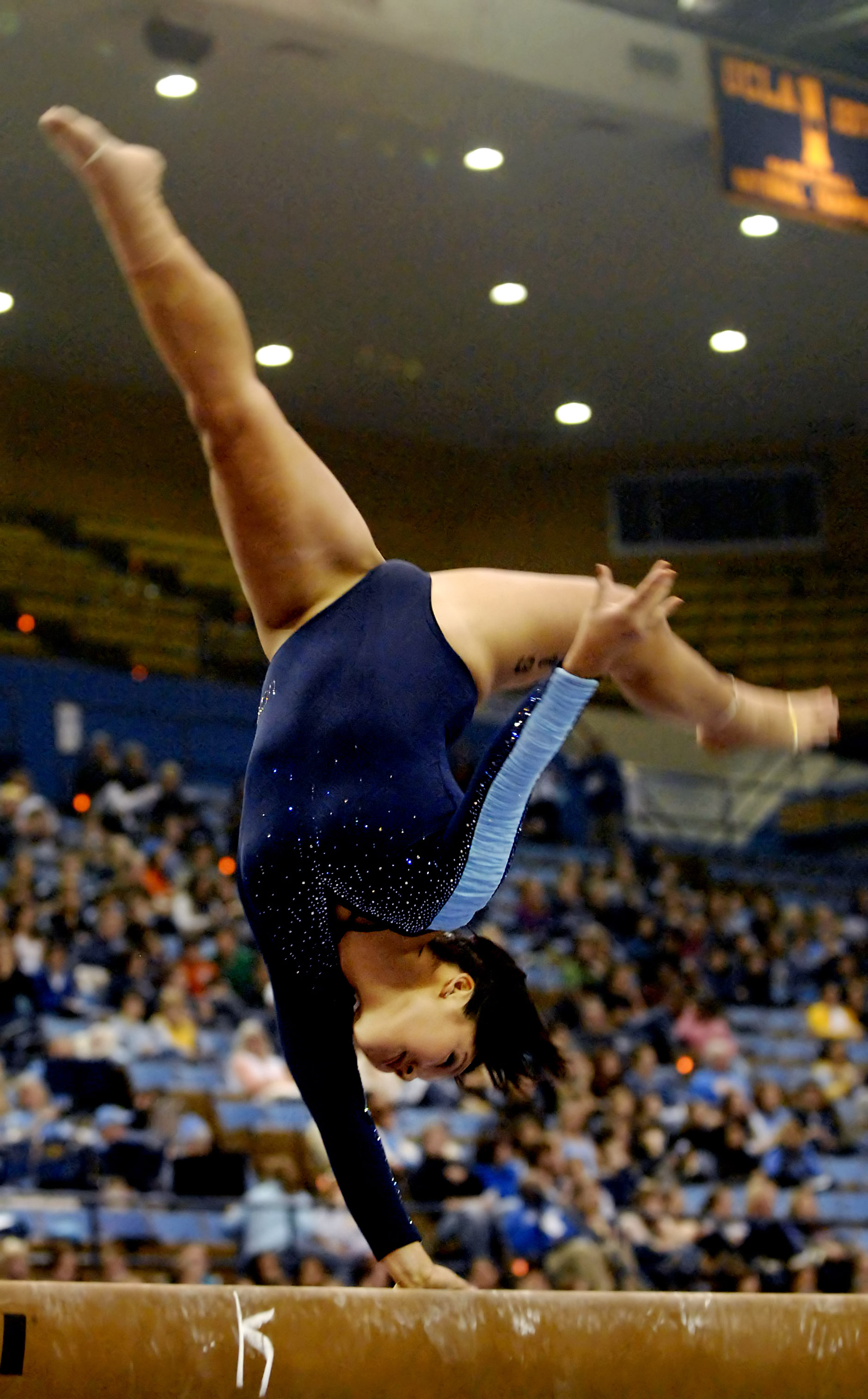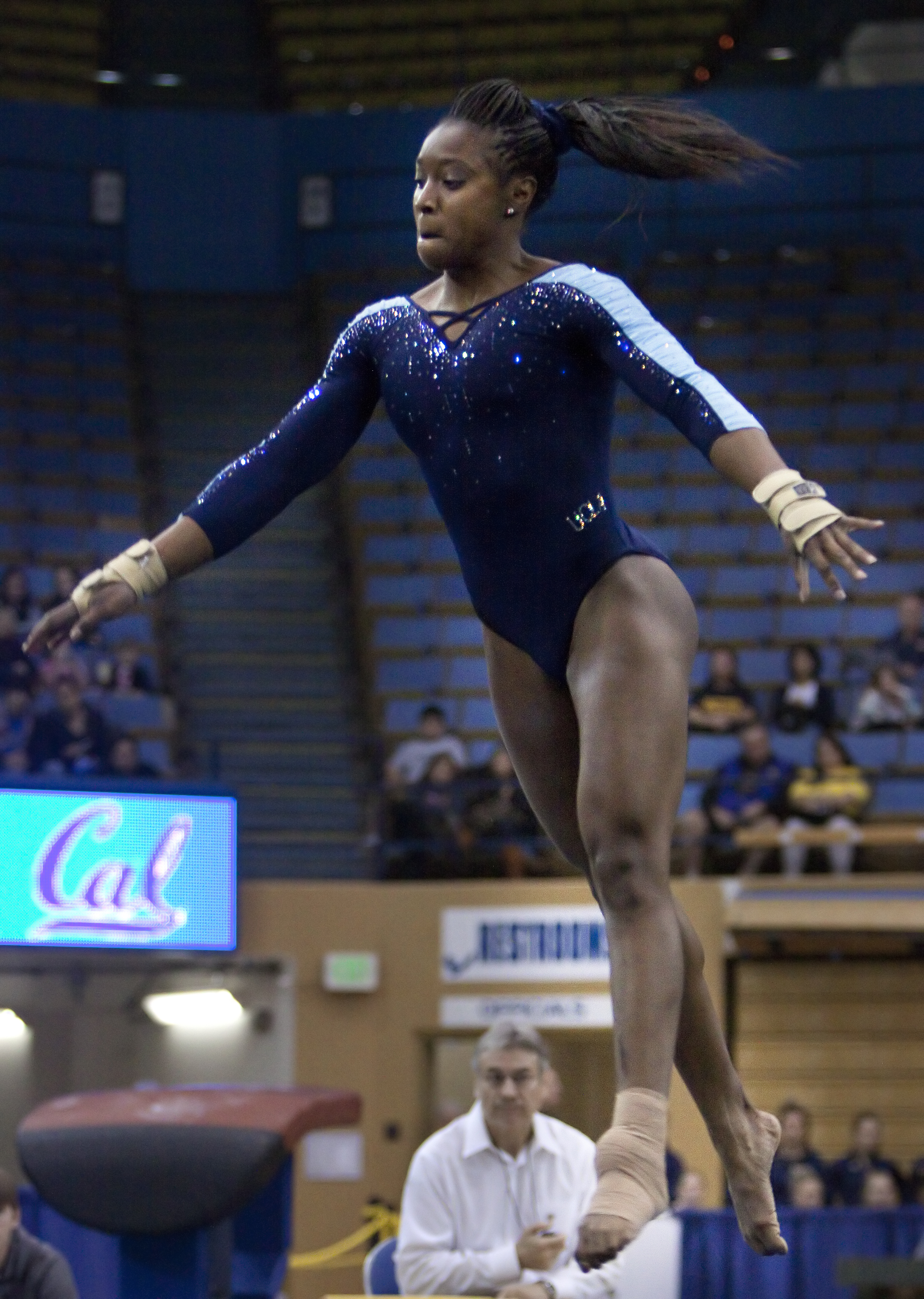
Senior Niki Tom performs on the beam at the Pac-10 Preview. Tom, a physiological science major, is one of many UCLA gymnasts who have to balance a difficult class load with being an NCAA Division I athlete.
Correction: The original version of this caption contained an error. The gymnast pictured is Niki Tom.
As Brittani McCullough scheduled an appointment for the weekend, she added it to a long to-do list in her big college-ruled notebook. The fifth-year nursing student, as well as the reigning NCAA individual champion in gymnastics, always has to be on top of her commitments, whether it’s on the gym mats or in the classroom.
But she’s not alone. McCullough is just one of many gymnasts who deal with balancing the life of a UCLA student and a UCLA athlete. Of the 21 girls on the roster, seven of them are math or science majors with four athletes in the physiological science major. Eight of the athletes want to pursue a career in the medical or health fields, and 15 of them are on the UCLA Director’s Honor Roll.
Despite being an NCAA athlete, McCullough decided to become a student in the notoriously challenging nursing school after getting injured in a car accident during her freshman year at UCLA, which forced her to sit out that season.
McCullough is taking just one course this quarter, but it is an “immersion” program which requires her to complete 300 clinical hours at the Santa Monica UCLA Medical Center. The program requires her to do 12-hour shifts at the hospital, which makes it difficult for her to train and travel with the team.
Even with her busy schedule, she still gets two to three practices a week, all while on the Director’s Honor Roll, which requires a GPA of 3.0 or higher.
“I have to make sure that when I’m in the gym, I don’t focus on anything else,” McCullough said. “I focus on getting better in the gym and making everything count. When I’m outside the gym and I’m at the hospital, I don’t think about anything else, just about what I’m doing there. It’s like compartmentalizing and focusing on whatever I’m doing.”
Though McCullough handles her schedule well, it doesn’t come easy for an entire team. When the Bruins started the season with lackluster scores, coach Valorie Kondos Field sensed a lack of purpose.
“The students’ classes don’t allow them flexibility, so the team has not trained together,” Kondos Field said. “They’ve had to come in early and they’ve had to leave early. However, their schoolwork comes first, so I have to figure out a way to integrate them more into the team purpose even though they may not be in the gym with the team four hours a day.”
McCullough as well as seniors Niki Tom and Mizuki Sato have inflexible schedules because of their academic commitments. Tom and Sato’s mandatory upper division physiological science courses are offered only during certain times.
When gymnasts miss parts of the practices, they have to make up for the time in various ways. Sato tries to finish her gym tasks before she goes to class and makes her turns count during practice. Tom practices early or at a different time. Junior Elyse Hopfner-Hibbs has had instances where she would leave training for class, and then come back right after to finish.
Tom has long aspired to be in the medical field and plans to take the MCAT next year. Though she finds gymnastics important, Tom and the team are focused on academics as well.
“We are encouraged to do well academically,” Tom said. “All of us want to succeed in the classroom and in the gym. We came to UCLA for school, so doing well in the classroom is definitely a number one priority.”
Doing well in school requires studying, and these athletes are able to get their studying done, even with the time they spend in the gym training and traveling to meets.
“Whenever I have an extra moment in between classes or between school and practice, I’ll just study,” Sato said. “I open up a book and study. We study a lot in the airport where we travel. We find time in the hotel. It’s just study, study, study!”
The gymnasts have a lot on their plate, and they divide nearly all of their time between studies and the gym.
“Of course we have to sacrifice a little, but what we get out of gymnastics is so much more than anything we need to sacrifice,” said Hopfner-Hibbs, also a physiological science student.
Along with all of this, these athletes need sleep. They cannot train without it, and the coaching staff even keeps track of how much sleep they get. With all of the things they have to get done, one would think that something has to give.
“We have no other option but to balance our work, our sleep and our training,” Tom said.
This kind of discipline even applies to the athletes when exams roll around. However, the gymnasts have the privilege of exercising some flexibility when it comes to class hours conflicting with practice.
“We can let the coaches know in advance that we can’t train a certain day because we have a midterm that night or the next day,” Hopfner-Hibbs said. “We have some freedom there, so that’s really nice. I know a lot of teams don’t have that.”
These feats on and off the mats are impressive and can be seen as a positive influence to the community. McCullough hopes she is a role model for younger athletes and gymnasts.
“It’s good for them to realize that it is possible to do well in school and to do well in gymnastics,” McCullough said. “You don’t have to give up your education or give up your athletics. It’s possible to do both. You just have to learn to balance your time.”
It looks like staying in balance during their gymnastics events is not the only balancing the gymnasts are able to do.
